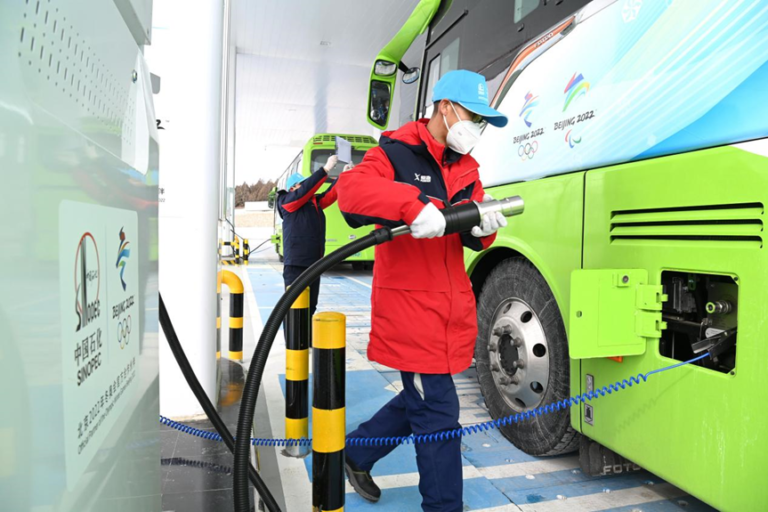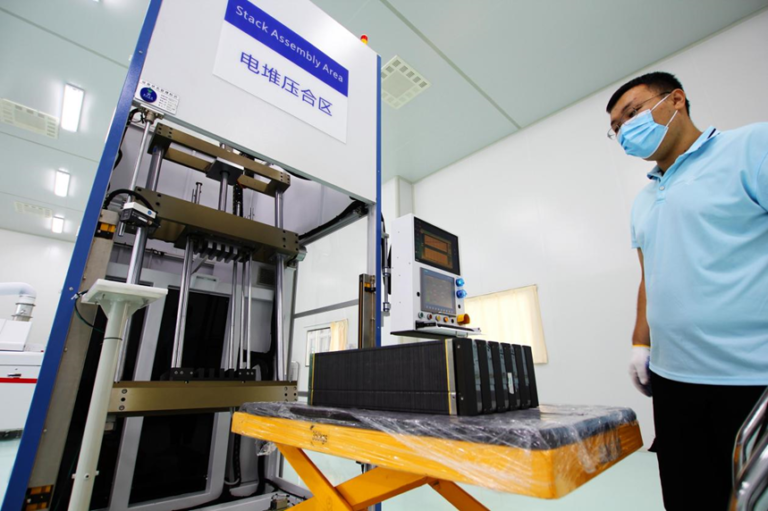
By Lu Yanan, People’s Daily
According to a development plan for the hydrogen energy industry released by Chinese authorities on March 23, China will build a complete hydrogen energy industry development system by 2035, when hydrogen produced from renewable energy will witness a significant increase in its proportion in final energy consumption and play an important role in underpinning the country’s green energy transition.
The medium- and long-term plan for the development of China’s hydrogen energy sector for the 2021-2035 period provided a scientific analysis of the industry’s current situation, and set out development goals for the industry by 2025, 2030, and 2035, respectively.
The country plans to preliminarily build a hydrogen energy supply system featuring by-product hydrogen from industrial processes and hydrogen produced near the point of end use from renewable energy during its 14th Five-Year Plan period (2021-2025), according to the plan, which was jointly formulated by China’s National Development and Reform Commission (NDRC) and National Energy Administration (NEA).
The plan states that by 2025, the ownership of hydrogen fuel cell vehicles in China will be increased to around 50,000; a batch of hydrogen refueling stations will be built across the country; and the country’s annual hydrogen production from renewable energy will reach 100,000 tons to 200,000 tons, which is expected to enable an annual reduction of one million tons to two million tons of carbon dioxide emissions.

China is the world’s largest producer of hydrogen, with a hydrogen production capacity of about 40 million tons per year and an annual hydrogen output of about 33 million tons.
The country’s hydrogen energy industry has initially acquired major technologies and production processes required for hydrogen energy production, storage and transportation, hydrogen refueling, hydrogen fuel cells, hydrogen energy system integration, etc.
The number of industrial enterprises above the designated size involved in the entire industrial chain has exceeded 300.
The utilization of hydrogen energy was an important embodiment of China’s vision of green Games at the just-concluded 2022 Olympic and Paralympic Winter Games. The 2022 Winter Olympics torch, named “Flying,” was fueled by hydrogen. In addition, a total of over 1,000 hydrogen fuel cell vehicles were put into use at competition zones and more than 30 hydrogen refueling stations were built for the Games, which achieved full use of green energy in transportation during the sports event.
The plan focuses on various key links in the production, storage, transportation, and application of hydrogen energy, as well as hydrogen safety, public services, and other aspects of the development of the hydrogen energy industry. It sets forth tasks including building an innovation system for the industry, advancing hydrogen energy-related infrastructure construction, steadily pushing forward with demonstration application of hydrogen energy, and improving relevant policy and institutional support systems.
While placing innovation at the core of the development of the hydrogen energy industry, the plan highlighted the importance of all-round development of the entire industrial chain, breakthroughs in key and core technologies, improvement in equipment’s capabilities of autonomous and controllable operation, and in-depth integration of industrial chain and innovation chain.
Considering infrastructure construction an important guarantee for the development of the hydrogen energy industry, the plan stressed the necessity of ensuring rational distribution of hydrogen production facilities, building hydrogen energy storage and transportation system in a steady and gradual manner, and making an overall plan for the establishment of a hydrogen refueling station network on the basis of overall planning for the nationwide layout of hydrogen energy industry.

The plan placed great emphasis on the application of hydrogen energy in a steady and prudent manner, as well as promoting demonstration application of hydrogen energy before large-scale application.
The application of hydrogen energy should be based on and driven by market demands, and its application scenarios in transportation, energy storage, and industry should be expanded according to circumstances and in a steady and prudent fashion, said the document.
The country will intensify efforts to promote the application of hydrogen fuel cell to medium- and heavy-duty vehicles, cultivate a new model of integrated application system featuring the combination of wind, solar, and hydropower generation and hydrogen energy storage, and carry out demonstration of microgrid with hydrogen energy storage system, the document noted.
According to the plan, China will fully utilize the guiding role of investment from the central government budget to boost the development of hydrogen energy-related industries; encourage financial institutions to support the development of hydrogen energy industry while managing risks and pursuing sustained development; and facilitate the efforts of eligible hydrogen energy companies to seek financing by listing on China’s sci-tech innovation board, commonly known as the STAR market, and the ChiNext board, the country’s Nasdaq-style board of growth enterprises.
“Hydrogen energy will become an important component in China’s national energy system. It is also a critical vehicle for achieving a green and low-carbon transition of final energy consumption, as well as a key development direction for strategic emerging industries,” said Wang Xiang, deputy head of the Department of Innovation and High-Tech Development of the NDRC.
According to Wang, hydrogen energy industry bears great significance for reducing greenhouse gas emissions, including carbon dioxide emissions, and achieving the country’s goal of peaking carbon emissions by 2030 and achieving carbon neutrality by 2060 .as a technology-intensive industry featuring wide coverage and a key role in driving the development of other industries
The industry will also inject new impetus into the high-quality development of the Chinese economy, Wang added.










